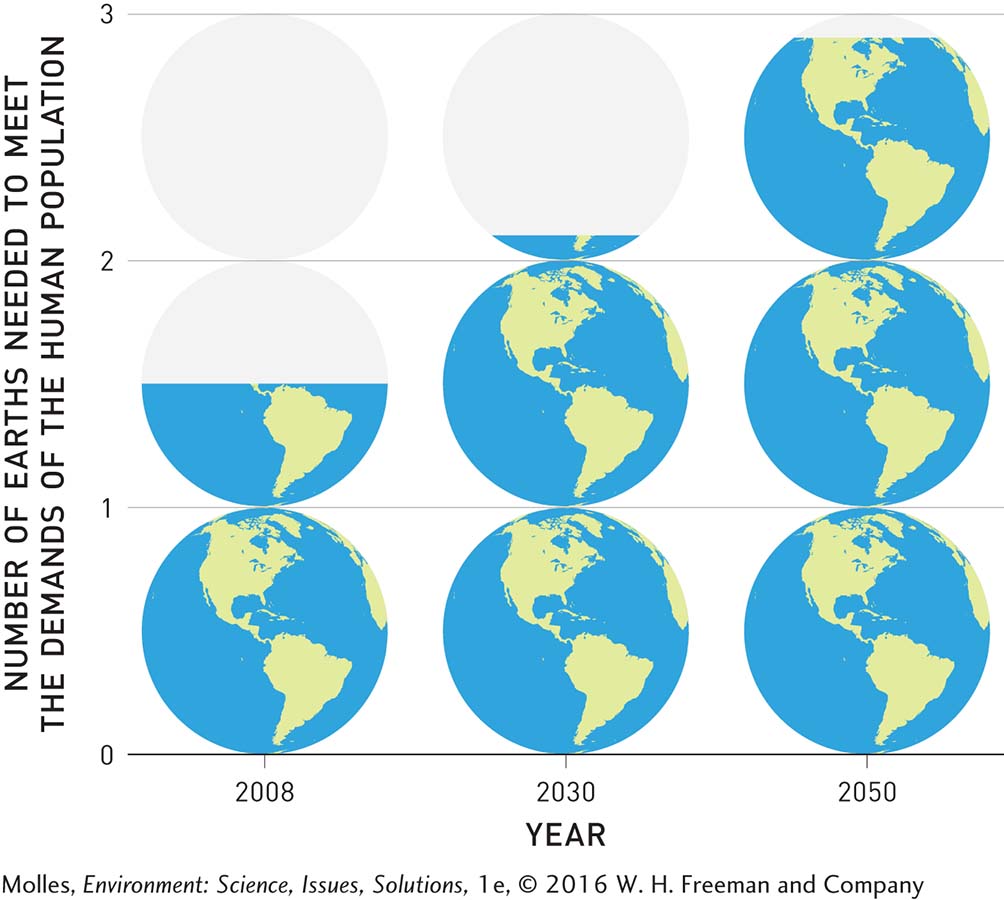1.6 Human impact on the environment has become a global issue
For much of human history, environmental impacts were local or regional. With the rapid growth of the human population during the past two centuries, however, our effects on the environment have extended to the entire planet.
Earth Day

How do you explain the rapid growth in participation in Earth Day celebrations?
The change to a broader environmental perspective is reflected in the history of Earth Day (Figure 1.23). Gaylord Nelson, U.S. senator from Wisconsin, began promoting the idea of a day to celebrate the environment and inform people about environmental issues in the early 1960s. The first Earth Day celebration was held on April 22, 1970. On that day, grassroots organizations across the United States organized events in which 20 million people participated, fully 10% of the U.S. population. In his speech in Denver on the first Earth Day, Nelson revealed that he was thinking broadly about what makes an environment healthy when he said, “Our goal is not just an environment of clean air and water and scenic beauty. The objective is an environment of decency, quality and mutual respect for all other human beings and all other living creatures.” By 2009 Earth Day was celebrated in 174 countries through more than 15,000 organizations, involving more than 1 billion people, or nearly 15% of the global population. As the Earth Day celebration grew, so did our sophistication in measuring our influence on the environment.

Ecological Footprint
ecological footprint The environmental impact of a human population as the area of land and sea needed to produce the resources it consumes and to absorb the wastes it produces.
One measure of human impact on the environment is called the ecological footprint, developed by Mathis Wackernagel of the Global Footprint Network and William Rees of the University of British Columbia. An ecological footprint represents the environmental impact of a human population as the area of land and sea needed to produce the resources it consumes, the area covered by infrastructure, such as buildings and roads, and the area of forest needed to absorb carbon dioxide emissions.
renewable resources Natural resources, such as wood, forage, or fish, that are replaced through natural processes on relatively short timescales and thus can last indefinitely under careful management.
nonrenewable resources Natural resources, such as fossil fuels, that exist in a limited supply and are not renewed on timescales meaningful to humans.
As shown in Figure 1.24, this index of environmental impact is based mainly on a population’s use of renewable resources, such as wood, crops, forage for animals, fish for human consumption, and forests for absorbing carbon dioxide. In principle, renewable resources can last indefinitely, since they are replaced through natural processes on relatively short timescales. The ecological footprint does not take into account a population’s use of nonrenewable resources, such as minerals or fossil fuels, except where their use impacts renewable resources and CO2 emissions.

How do the human impacts on the environment not included in ecological footprint calculations affect our actual footprint?

The Global Footprint Network has estimated that there were approximately 12 billion hectares of productive Earth surface in 2008, while the ecological footprint of the global population required 18.3 billion hectares (Figure 1.25). In other words, human use of natural resources was approximately 50% higher than Earth’s capacity to replace them. As a result, it took one and a half years for Earth to replace the resources consumed, and to absorb the CO2 emissions of the global population in just one year. According to the 2012 Living Planet Report, our ecological overdraft will rise to a bit over 100% by 2030 and to nearly 200% by 2050. At that point, if present trends continue, the productive capacity of three Earths will be needed to meet our single Earth’s human demand.

Ecological footprints can also be calculated for individuals and countries. For instance, individuals in rich, highly developed nations, in general, have a much larger ecological footprint than do individuals in developing nations. If each of the 7 billion humans on Earth in 2012 had the ecological footprint of an average person in the United States, approximately four Earths would be required to support them. Calculations of humanity’s ecological footprint demonstrate that concerns over our impact on the environment are justified. The growing impact of humans on the environment presents one of the greatest challenges ever faced by our species. What do you think we should do in the face of this challenge? How can we address the immense problems that we face?
Think About It
What is the value of a movement such as the Earth Day celebrations? What is the significance of the massive participation in Earth Day celebrations around the world?
How does the ecological footprint approach to estimating the mismatch between human needs and Earth’s productive capacity differ from that of Malthus?
1.5–1.6 Issues: Summary
Human impact on the environment has gradually increased through the course of our history. Awareness of the environmental harm caused by human populations increased substantially in the 18th through 20th centuries as a result of the work of Benjamin Franklin, Thomas Malthus, George Perkins Marsh, and others. John Muir, Gifford Pinchot, and U.S. President Theodore Roosevelt were active in land preservation and conservation. Rachel Carson warned of the potential dangers of indiscriminate use of chemical pesticides in her book Silent Spring. Awareness of environmental issues has grown beyond local and regional perspectives to include the entire Earth. The global extent of environmental concern is reflected in the growth of the Earth Day celebration. The impact of the human population can be measured by the ecological footprint, which indicates that human pressures have grown rapidly beyond the capacity of Earth to supply renewable natural resources and absorb carbon dioxide.